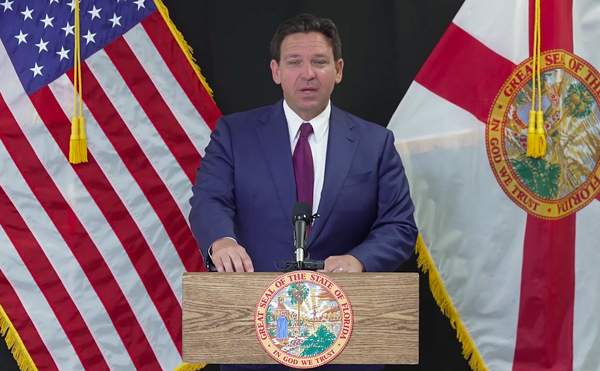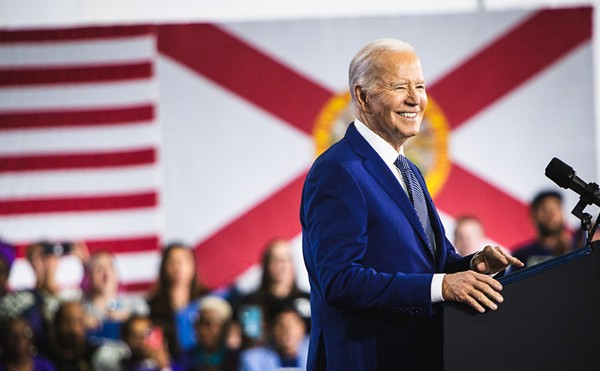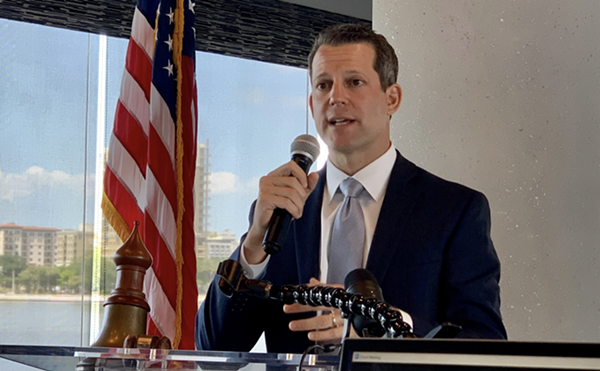Two weeks after the 9/11 terrorist attacks shocked America, Al-Arian appeared on Fox News’ O’Reilly Factor. Although Al-Arian said little if anything of substance on the program, just having O’Reilly recite the previous allegations about Al-Arian to a nationwide audience was enough to enrage an angry American populace, and USF was littered with calls and emails attacking the school for employing him.
(In the program, O’Reilly asked Al-Arian about former WISE official Ramadan Shallah, who after departing Tampa in the ’90s soon became the head of the Palestinian Islamic Jihad, or PIJ, a Middle East group officially labeled a terrorist organization by the U.S. State Department in 1997.)
USF placed Al-Arian on paid leave less than 48 hours after his Fox News appearance. Then stunningly, a few days before Christmas in a move led by trustee Dick Beard, the university announced that the professor would be fired.
For the next year and a half, speculation spread that the FBI was investigating Al-Arian, and that the next shoe would drop at anytime. In late February of 2003, it finally did, when Al-Arian was arrested with three others and charged in a 50-count indictment with assisting the PIJ.
His trial finally began in June of 2005. In another dramatic moment in the history of the case, on December 13th, 2005, the federal jury in Tampa acquitted Al-Arian on eight of 17 counts and deadlocked on the others with 10-2 favoring acquittal.
But Al-Arian was not freed from jail. In February of 2006, he admitted to one count of conspiracy to contribute services to or for the benefit of the PIJ. For his detractors (including some, like the St. Petersburg Times editorial board, who had defended him but then turned tail after the feds intervened), it was a literal admission of guilt, case closed.
For his supporters, however, it was seen as a step toward establishing a specific date for his release. But the odyssey continued when Al-Arian refused to testify in a different case involving an Islamic think tank in Northern Virginia. He went on several hunger strikes to express his anger at his treatment.
Finally, this past spring, Sami al-Arian was freed after immigration officials failed to explain his continued detention pending a trial for refusing to testify before a grand jury.
The final chapter will extend into the coming decade; currently Al-Arian remains under home detention at his daughter’s residence in Virginia.
[image-1]
2. Terri Schiavo (2005)
Terri Schiavo collapsed in her St. Petersburg home in 1990 and fell into a persistent vegetative state. The dispute that followed — her husband, Michael Schindler, wanted her taken off life support, saying that would have been her wish, and her parents disagreed — drew some attention in the first part of the decade, but media coverage went full DEFCON4 in the spring of ’05. That’s when the Florida Legislature, Congress, Jeb Bush and ultimately President Bush joined the debate after courts ruled that Michael Schiavo could pull the feeding tube from his wife.
In the remaining weeks of her life, Schiavo became a symbol for the Christian conservative wing of the GOP — including a staffer for then newbie Senator Mel Martinez, who wrote a memo lauding the Schiavo case as “a great political issue” for Republicans because “the pro-life base will be excited” and it “is a tough issue for Democrats.” The case ultimately led George W. Bush to rush back from his ranch in Crawford, and in the middle of the night in his pajamas signed a bill that would grant him jurisdiction on the case.
Despite the unprecedented attempts at federal intervention, Terri Schiavo was finally taken off her feeding tube per court orders; she died days later on March 31, 2005. On June 15, 2005, the results of the autopsy performed by the medical examiner’s office on Schiavo were released to the public, which “backed her husband’s contention that she was in a persistent vegetative state, finding that she had massive and irreversible brain damage and was blind.”
3. Florida Recount (2000)
Flori-‘duh’ became part of the lexicon after the dramatic 36-day recount in November and December of 2000 during which the Sunshine State dominated the political world — and I do mean world.
Political experts (including most famously the late Tim Russert) predicted the George W. Bush/Al Gore election would come down to “Florida, Florida, Florida,” and both campaigns knew it. Vice President Gore began Election Day at 4 a.m. in Tampa, and what followed was both sideshow (enough with the photo of a guy looking at a butterfly ballot with a magnifying glass!) and high drama, as the country’s leadership remained in question until the U.S. Supreme Court intervened in what liberals called the “selection” of Bush to be president.
I have many memories of that time, but none more vivid than the day I spent in West Palm Beach three days into the recount. Our democracy seemed literally up for grabs at that moment, and conservatives were far louder and more prominent on the streets than Democrats were, for whatever reason. I remember visiting a retirement village of over 10,000 seniors, bumping into legendary newsman Jimmy Breslin and interviewing older Jewish men and women who were insisting that they had intended to vote for Gore, but due to the butterfly ballot had mistakenly cast their selection for Pat Buchanan.
One of the winners in that process was Pam Iorio, who as head of the state’s association of supervisors of elections was featured nationally. She allowed Hillsborough, unlike so many Florida counties, to come out of the imbroglio smelling pretty good. (The county’s sterling reputation would come under question a few years later, of course; see “#8: Buddy Johnson’s reign of error.")
4. Four hurricanes in seven weeks (2004)
Their names were Charley, Frances, Ivan and Jeanne, and between the middle of August and late September ’04 they terrified the state as Al Qaeda had three years before.
On August 13, St. Petersburg Times readers picked up their paper to read a large headline blaring, “Target: Tampa Bay.” For the first time in over 80 years, it seemed a hurricane was heading inexorably toward the Tampa metro area.
Then, miraculously enough, the trajectory of Charley’s path dipped just two hours before it was to hit shore and instead caused mayhem south of Sarasota.
Three weeks later, Frances made her appearance. Unlike Charley, Frances was slow but wide, encompassing the entire state. The storm never hit Tampa directly, yet when it departed westward on the Sunday night of a Labor Day weekend, it kicked up a huge backlash of water that left parts of downtown Tampa partially submerged on Labor Day.
Next up was Ivan, which ended up killing six people, all in the Panhandle where its impact was most felt before it crashed through Alabama.
And last but certainly not least was Jeanne, which hit on Sunday, September 26. Though its route did not take it through Tampa, it knocked power out for several days for tens of thousands of people (as had Ivan).
When the eventful hurricane season was all over, Governor Jeb Bush and Emergency Manager Craig Fugate won plaudits for handling the incredible stress and strain on the state. (Fugate now runs FEMA for President Obama.)
[image-2]5. The firing of Steve/Susan Stanton (2007)
The story of the longtime city manager of Largo made national headlines two and a half years ago. As CL Editor David Warner wrote at the time, “When the Largo City Commission voted Tuesday to place him on administrative leave with intent to dismiss, he went from local notoriety to international cause celebre.”
Stanton had worked for the city of Largo for 17 years — 14 as city manager, where he had received relatively good notices (though some said at times he could be abrasive). But his life turned upside down on February 21, 2007 when the St. Pete Times reported that Stanton was transgender and in the process of having sex reassignment surgery.
A public hearing was held in Largo on February 27, 2007, lasting over four hours and attended by over 400 people. The Largo City Commission voted 5-2 to place Stanton on administrative leave before ultimately canning him.
After applying for over 100 city administrative jobs, Susan Stanton was hired by the city of Lake Worth as its city manager in April of this year.
6. Hillsborough County bans gay pride (“little g, little p”)
A particular low moment for the Tampa Bay area occurred back in June of 2005, when a controversial book display during gay pride month at some Hillsborough libraries led then Commissioner Ronda Storms to ban all gay pride events in the county.
The motion by Storms caught gay rights advocates and basically everybody else by surprise. While bringing up the issue about the library display, Storms said, “I move that we adopt a policy that Hillsborough County government abstain from acknowledging, promoting or participating in gay pride recognition and events, little g, little p.”
The vote was 5-1 to support the motion, with only Kathy Castor dissenting. Castor, now a Congresswoman, said at the time, “I think it’s inappropriate for government to promote discrimination.”
Just to make sure that any future Commission of a possibly less hateful bent might want to overturn the measure, the crafty Storms then made a second motion, calling for such a reversal to require a supermajority, 5-2 vote. That passed 6-1, with Castor again being the lone dissenter.
The move rocked the LGBT community and their friends and supporters in Tampa and Hillsborough, leading to a street protest that drew around 1,000 people to Tampa several weeks later.
Recently, the Tampa City Council added transgender to its human rights ordinance. City Council Chairman Thomas Scott said before that vote that he had never voted for any type of gay rights legislation in the past, and that was absolutely accurate.
7. Tampa Bay chooses LGBT leaders (2008, 2009)
Kevin Beckner was elected to Hillsborough County Commission in 2008, Steve Kornell elected to St. Pete City Council in 2009 and Jane Castor was named Tampa Police Chief in 2009. The significance of these three individuals is that they’re all openly gay or lesbian, and there was little if no controversy in either their campaigns or appointments. At the end of the decade, it could be argued that the moves weren’t that historical, but coming after the 2005 vote in Hillsborough, it was definitely significant that Kevin Beckner won, and won decisively over Brian Blair.
8. Buddy Johnson’s reign of error (2003-2008)
Former State Senator Buddy Johnson was named by then Governor Jeb Bush to replace Pam Iorio as Hillsborough Supervisor of Elections in 2003. Despite some mistakes, Johnson, buffeted by his name recognition and the fact that 2004 was a strong year for Republicans locally, easily beat Democratic challenger Rob McKenna for the job.
But then the mistakes kept happening. In a series of outstanding reports in the St. Petersburg Times (most by Jeff Testerman with assists from Michael Van Sickler and others), we learned that Johnson was one of our most incompetent public officials, perhaps ever. That might be too harsh a charge, so let’s just say in the aughts in Tampa Bay, Buddy took the honors.
The FBI is still investigating what happened to nearly a million dollars that Johnson overspent in the Supervisor of Elections’ budget in his last year in office. Buddy lost his bid for re-election in November of 2008 to Phyllis Busansky, whose unexpected death in 2009 saddened the community.
Testerman and company have reported on a number of irregularities emanating from Johnson’s office, none more egregious than the report that in May of 2008 a process server tried to subpoena Johnson for 18 days for his testimony on a voting rights lawsuit, never finding him, with his staff clueless to his whereabouts.
9. Obama beats McCain in Florida and wins the White House (2008)
Barack Obama made several stops in the Bay area in the last months of the campaign, none more memorable than his appearance at Steinbrenner Field in Tampa on the first day of early voting. There Tampa Bay Rays pitcher David Price, less than 12 hours after being mobbed on the mound after the Rays defeated the Boston Red Sox to go to the World Series, introduced Obama.
The state was considered too close to call until two critical events in September: the announcement by Obama campaign manager David Plouffe that they would spend $40 million in Florida to try to win the state, and the financial crises, which would also rebound in Obama’s favor.
Also, it was at a Sarah Palin event in Clearwater where a man was allegedly heard to utter “kill him,” referring to Obama. The Alaska governor brought enthusiasm to events in Tampa Bay in ways that John McCain could never muster, including an embarrassingly low-attended event in Tampa the day before the election.
10. Tampa Bay teams win! (2003, 2004, 2008)
For much of its two decades of existence, the Tampa Bay Buccaneers were pretty much nothing more than a good punch line for Johnny Carson. Then Tony Dungy was hired in the mid 1990s and dramatically changed the franchise in a positive fashion.
But after successive playoff losses, the Glazer family fired Dungy in early 2003 and ultimately replaced him with the dynamic young coach of the Oakland Raiders, Jon Gruden. Acquired in an unconventional trade, Gruden was able to inspire the Bucs to a new horizon, and they blasted the favored Oakland Raiders in the Super Bowl in San Diego in January of 2003.
Days later a giant parade was held off of Bayshore Boulevard in Tampa. A year later, the Tampa Bay Lightning would win the Stanley Cup, and in 2008, the area’s third major sports franchise, the Tampa Bay Rays, would exorcise a decade of being the laughing stock of the American League and go to the World Series, where they lost 4 games to 1 to the Philadelphia Phillies.
















